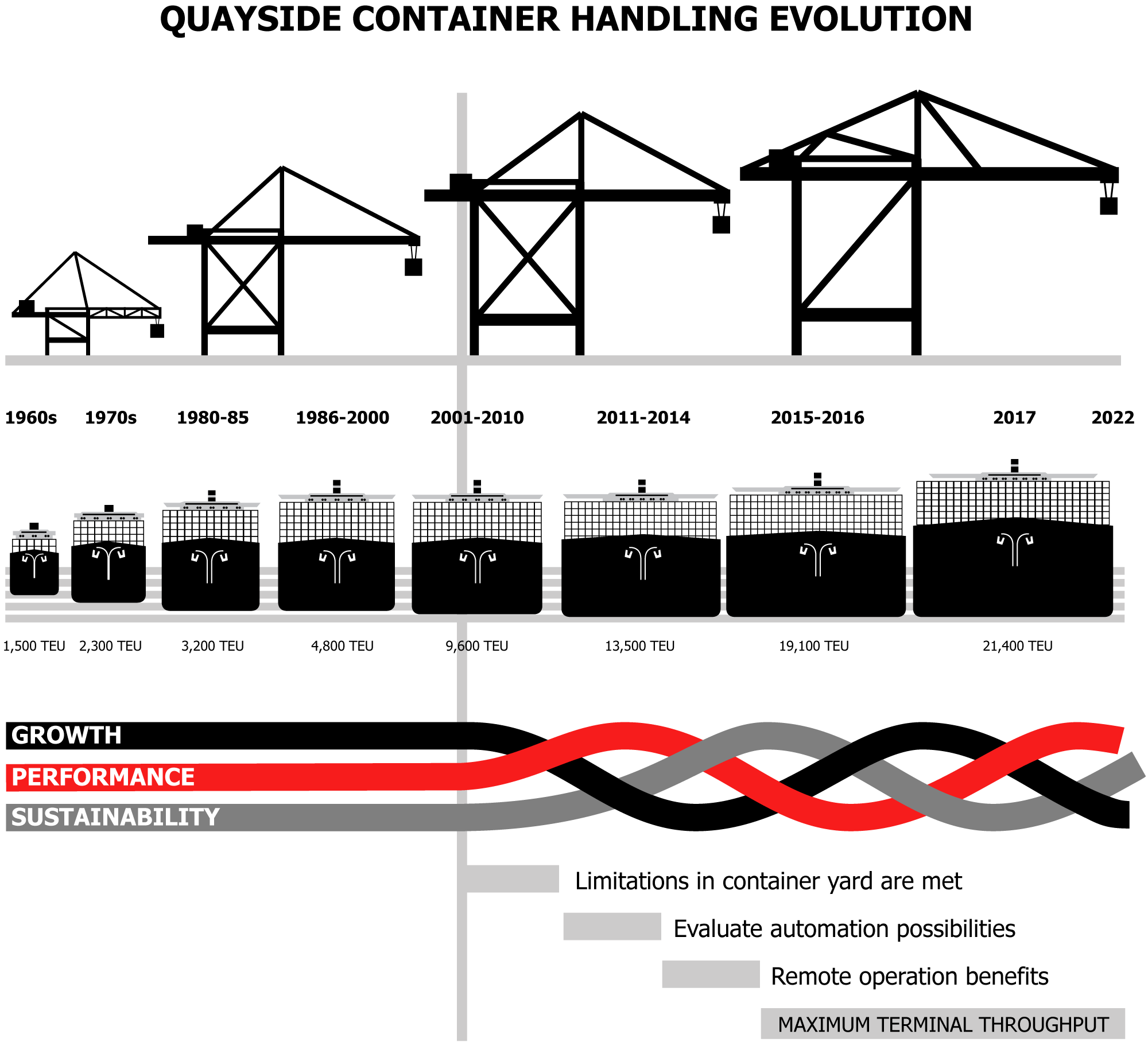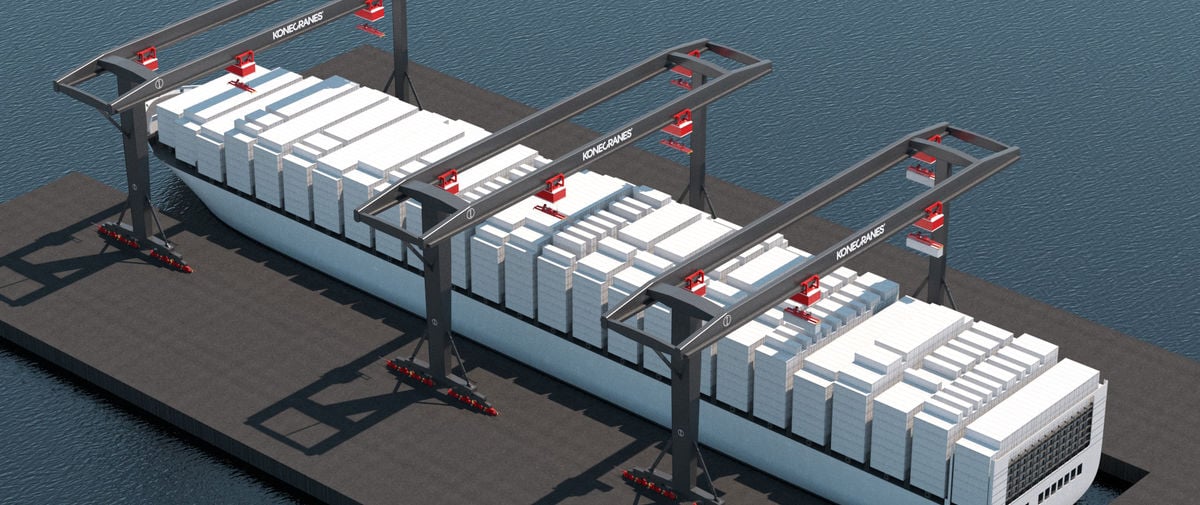The world’s first commercially successful container ship took just 58 containers from Newark to Houston in 1956. Now, in 2021, the world’s largest container vessel can carry 23,992 TEU. Sea freight has changed a lot in the last 65 years.
CONTAINER DEVELOPMENT
Various kinds of containers have been used in maritime transportation since the late 1700s, but the commercial container industry did not really develop until after the Second World War. The real breakthrough came with the invention of the modern standardized container, or TEU, used on that first ship in the 1950s. By 1970, container vessels could carry over 1,000 TEU, and the 1980s saw the introduction of Panamax class container ships, designed to fit the Panama Canal, carrying 4,000 TEU. By the end of the twentieth century, maximum container ship volume was up to 8,500 TEU.
Two decades later, the average port call today is 10,000 TEU. In addition, there are more than 80 container ships in service around the world with a capacity of over 20,000 TEU. Officially, these are called Ultra Large Container Ships (ULCS). Unofficially, they are often referred to as “megaships”.
Ultimately, giant ships are an economy of scale meant to reduce operating expenses. If 20,000 containers fit on one vessel, it’s cheaper than putting 5,000 containers on four vessels, when every ship has costs like parts, maintenance, fuel and crew. But simple math also tells you that it takes much longer to unload a big ship than a small one, and that means the shipping line pays the seaside container terminal more in berthing fees. From a business perspective, the aim is to minimize the time in any one container terminal.
to reduce operating expenses. If 20,000 containers fit on one vessel, it’s cheaper than putting 5,000 containers on four vessels, when every ship has costs like parts, maintenance, fuel and crew. But simple math also tells you that it takes much longer to unload a big ship than a small one, and that means the shipping line pays the seaside container terminal more in berthing fees. From a business perspective, the aim is to minimize the time in any one container terminal.
CONTAINER CRANE DEVELOPMENT
How long a container ship spends in port is in large part determined by the efficiency of its container cranes. First available on the market in 1959, the ship-to-shore (STS) crane has been dominant in quayside container handling for over 60 years. Konecranes sold its first STS cranes to the Port Administration of Stockholm, Sweden, in 1969. Since then, customer needs coupled with steadily improving technology have driven the development of this crane type.
The latest Konecranes STS crane is designed for 4 million fatigue cycles. In practice, this means it will last well over 20 years. Its Core of Lifting components require little maintenance and are easy to access, with minimal hoist ropes, halved bearing houses for sheave packages and limited hydraulics. In a comfortable, ergonomic cabin, the operator uses well-tuned, intuitive controls set at manual or semi-automated settings for increased precision and safety. Over time, the cranes have also grown in size as they have needed a longer outreach and a greater height to handle containers from ships that have kept getting bigger.
Konecranes has a vision for the next generation of STS crane. It’s a concept where overhead cranes straddle the megaship: double-beam portals with two trolleys per beam, with shorter trolley distances for very fast unloading from both sides. Dampening measures coupled with no trolley rail joints give less maintenance, less structural fatigue, and even longer crane lifetime. Read more HERE if you are interested.
CONTAINER TERMINAL INFRASTRUCTURE
But having the right cranes is only part of the story. Every container terminal needs a well-balanced infrastructure to ensure it can handle every one of the ships that call. With average ship volumes increasing, terminals have to prepare for increasing size. To accommodate the megaships, the quay must be long enough to dock a 400 m vessel. A bulkier crane might require strengthening of the dock supports. Big cranes are not efficient with small vessels, as longer hoist and travel distances, technical issues, and stacking on the quayside can cause delays.
Konecranes’ next-generation STS concept requires some initial investment to create the indented berths needed for the straddle design. Here, detailed investigation needs to be done into how to handle the much increased water pressure of the ship coming into the quayside. That said, the next-generation STS concept can solve many of the challenges on the quayside. By dividing the weight of the crane symmetrically, it eliminates the problem of stress on one extended arm and reduces foundation requirements and quay load, especially with the new structural materials that reduce its overall mass. With much faster unloading, fewer cranes are needed to do the same job, reducing purchasing and operating costs and maximizing the use of available space.
The new STS concept is not intended to replace the traditional STS – instead, it provides ports with the flexibility required when the megaships come to call. Smaller container ships will still be used. However, every crane in the container terminal must be properly integrated with the port’s business mission and what is available in the surrounding logistics ecosystem. There must be enough unloading space on the quayside and room for stacking in the container yard, ensuring efficient container movement around the terminal. Support functions need to be in top shape to serve customers as they require.
SUMMARY
Container ships and container cranes have changed a lot over the decades as the container became the prime unit of modern world trade. Every container terminal is more than the sum of its container cranes: it is part of a global logistics ecosystem, with the mission of ensuring that every container passing through its gates reaches its destination quickly and safely. A good container terminal uses ultra-efficient container handling equipment within a well-designed infrastructure to handle container ships of all sizes.
Megaships included.

 to reduce operating expenses. If 20,000 containers fit on one vessel, it’s cheaper than putting 5,000 containers on four vessels, when every ship has costs like parts, maintenance, fuel and crew. But simple math also tells you that it takes much longer to unload a big ship than a small one, and that means the shipping line pays the seaside container terminal more in berthing fees. From a business perspective, the aim is to minimize the time in any one container terminal.
to reduce operating expenses. If 20,000 containers fit on one vessel, it’s cheaper than putting 5,000 containers on four vessels, when every ship has costs like parts, maintenance, fuel and crew. But simple math also tells you that it takes much longer to unload a big ship than a small one, and that means the shipping line pays the seaside container terminal more in berthing fees. From a business perspective, the aim is to minimize the time in any one container terminal.